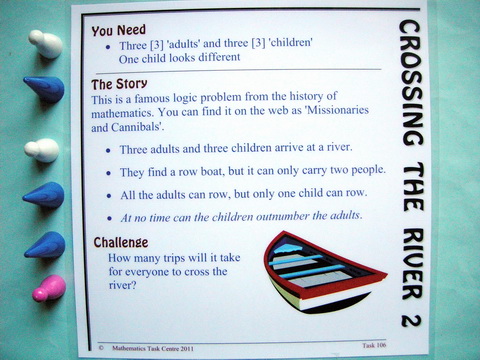
Crossing The River 2Task 106 ... Years 2 - 10SummaryThis is a classic problem from the history of mathematics. In other places it goes by the name of Missionaries & Cannibals. It requires no previous knowledge of mathematical skills - emphasis is on reasoning, as it always is with mathematicians. The challenge is to get three adults and three children across a river given certain restrictions. |
Materials
Content
|

IcebergA task is the tip of a learning iceberg. There is always more to a task than is recorded on the card. |
Perhaps the first thing students need to realise is that the 'At no stage' rule applies in the boat and at the moment the boat docks at either bank. However given the boat can only take two people, the possibilities are AA, AC and CC, so there will never be outnumbering in the boat. The focus then shifts to peering across to the other bank to see what the A/C balance will be while simultaneously observing the current bank. It's a bit like keeping your finger on a piece in chess while you are testing a move. One solution is:
Thirteen crossings altogether. The beginning can be different, but in the same number of moves it results in three children on the End Bank. Solving this problem is one challenge. But once a mathematician has solved a problem they must be able to explain it to their colleagues. Explaining the solution to someone else - not just telling, but explaining - is the next level of challenge. Then...
To develop the problem further you might ask:
Now try another famous river crossing problem such as: A farmer arrived at a river bank with a fox, a goose and a bag of wheat. He hired a boat to cross the river, but the boat could only carry the farmer and one other thing - the fox or the goose or the bag of wheat. His extra difficulty was that, if left alone, the fox would eat the goose, and the goose would eat the wheat. How could he get himself and his things safely across the river?Returning to the original problem, more senior students might be challenged to consider that at each stage of the solution there are implied tests:
Writing a program to solve this problem was a challenge budding programmers had to face in the early days of developing programming languages such as Fortran. The first step was to design a flow chart that allowed the computer to try every possible case (because we are teaching it to solve the problem, not just training it to retell our previously constructed solution) and include tests that separate the legal from the illegal moves. Given this historic story shell, students might like to attempt such a flow chart. |
Whole Class InvestigationTasks are an invitation for two students to work like a mathematician. Tasks can also be modified to become whole class investigations which model how a mathematician works. |
If you want all students to be working on this activity at the same time - a whole class investigation to model the work of a mathematician - you only need three colours of counters or blocks. If you have Poly Plug they are perfect because, for example, the adults can be blue, the child rower can be yellow and the other children can be red. Consider acting out the problem to begin the students' interest. Perhaps the students will find a solution as a class this way, but if not, the 'plot' will be established and you will be able to record key insights on the board. As appropriate, move from physical involvement to the table top version with Poly Plug. Even if the problem has been solved as a class, the challenge is for each pair to be able to recreate the solution. As some come to know the solution well, shift the emphasis of the lesson onto explanation. Suggest that those who have not yet conquered the solution could invite someone else to assist. However, the tutor must speak only and keep their hands behind their back. When all are confident they can do the problem, remind students that part of a mathematician's work is to explain their solution to others. Challenge students to record the solution in their journal using words or pictures or symbols or a combination. Suggest that there might be some who would like to use their computing skills to produce an animated solution. This might be as straightforward as taking still photos with a digital camera and using the full version of Acrobat, or other software, to produce a self-running slide show. The main thrust of the lesson is to highlight the reasoning and communication skills of a mathematician - values highly regarded by most, if not all, current mathematics curriculum documents. The advantage of the problem is that it requires no previous mathematical skill knowledge and it opens the door to a broad range of teaching craft techniques such as:
At this stage, Crossing The River 2 does not have a matching lesson on Maths300. Visit Crossing The River 2 on Poly Plug & Tasks. |
Is it in Maths With Attitude?Maths With Attitude is a set of hands-on learning kits available from Years 3-10 which structure the use of tasks and whole class investigations into a week by week planner. |
The Crossing The River 2 task is an integral part of:
|